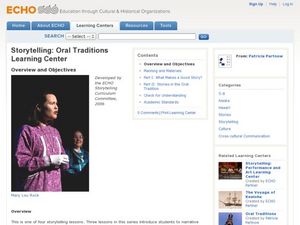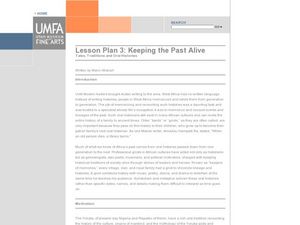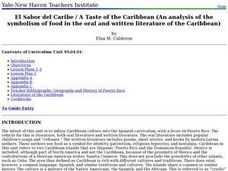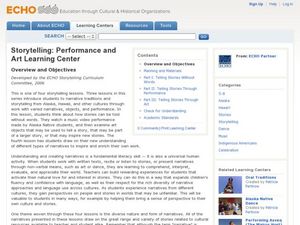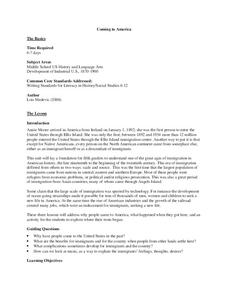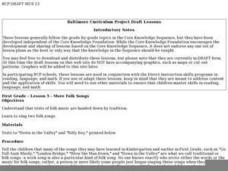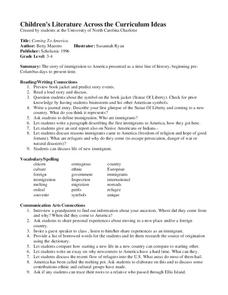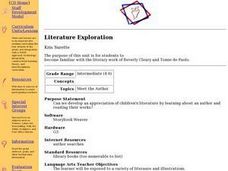Curated OER
Storytelling: Oral Traditions Learning Center
Students explore the oral traditions. In this storytelling lesson, students compare and contrast stories from the cultural traditions of Alaska and Hawaii.
Teaching Tolerance
Oral Interviews
Show class members how personal history can be using an oral interview project. Even the youngest learners engage with history using a resource to create and execute interviews with members of their community. The activity walks a class...
Curated OER
Maurie Japarta Ryan, Oral History Analysis
Students research Australian History as it relates to the separation of Aboriginal and Torres Strait Islander children from their families. In this Maurie Japarta Ryan lesson, students apply specific skills pertaining to...
Reed Novel Studies
The Railway Children: Novel Study
How can you prove your innocence? After being falsely accused and placed in prison, the father in The Railway Children is looking for the answer to the question. The children make friends with an elderly gentleman who helps them prove...
Curated OER
Keeping the Past Alive
Students read about the oral histories of West Africa and complete related activities. In this oral histories lesson, students read about the importance of oral customs in African cultures. Students interview a family member about oral...
Curated OER
A Taste of the Caribbean
Young scholars are introduced to the foods and traditions of the Caribbean. In groups, they brainstorm their own definition of culture and review the physical and political geography of the Caribbean. They spend time sampling different...
Curated OER
Storytelling: Performance and Art Learning Center
Tenth graders explore the process of telling stories without words. For this literature lesson, 10th graders watch a music video performance made by Alaska Native students, and then examine art objects that may be used to tell a...
Curated OER
Using Oral History to Understand Immigrant History
Young scholars use oral history to comprehend how life chaned for men, women, and childern when they immigrated to the United States. Students conduct interviews with immigrants in an attempt to interpret hardships, lifestyles, careers,...
Curated OER
How to incorporate local history into your Arkansas History class
Fifth graders explore their local history through research and then providing reenactments about the history.
Curated OER
Children in Hiding During the Holocaust
Students examine the different ways in which children hid trying to escape the concentration camps. Using journal entries, they put themselves into the role of the children and imagine their feelings during the Holocaust. They discuss...
Curated OER
Lesson plan: History Underfoot
Students study Native Americans of Virginia. For this Virginia history lesson, students take on the role of archaeologists as they analyze a site and its artifacts. Students use the information to draw conclusions about the natives who...
Curated OER
Dramatizing Your Story
Students write a script, planning and recording improvisations based on personal experience and heritage, imagination, literature and history.
Maryland Department of Education
Our Children Can Soar
Amazing efforts of African American leaders are celebrated in a lesson on civil participation. The engaging resource focuses on primary and secondary sources to analyze the impact of African American leaders such as Ella Fitzgerald....
Tellagami Labs
Tellagami
Bring the world of video messaging into your classroom with this creative communication application. Offering the ability to create animations with customized characters, backgrounds, and recorded messages, this resource is guaranteed to...
Curated OER
Coming to America
Through this set of three lessons about Ellis Island, class members will learn about why immigrants came to the United States, find out about the difficulties that went along with coming to America, become familiar with the immigration...
Mary Pope Osborne, Classroom Adventures Program
The Backpack Travel Journals
Strap on those backpacks, it's time to travel through history with this literature unit based on the first four books of The Magic Tree House series. While reading through these fun stories, children create story maps, record...
Curated OER
Texture Hunts and More: Madonna and Child with Saints
Students investigate different painting techniques by studying classic works of art. In this art history lesson, students observe the famous Madonna and Child with Saints painting and describe the texture and images they notice....
Curated OER
"Me and My Family Tree"
Students explore genealogy by reading a family history book in class. In this family tree lesson, students read the story Me and My Family Tree by Joan Sweeney and discuss their own family history. Students identify what the term...
Curated OER
More Folk Songs
First graders explain that texts of folk music are handed down by tradition. They sing two folk songs.
Reed Novel Studies
One-Eyed Cat: Novel Study
The Great Depression was a devastating period in American history that lasted for an entire decade. Using an enlightening novel study, scholars uncover additional facts about the era. They also write quatrain poems focusing on themes...
Curated OER
Oral Assessment Plan
Learners practice active listening skills. In this literacy and U.S. history lesson, students predict the hardships pioneers using the Mormon Trail might have faced. Learners view the movie "Children of the Wagon Train," then...
Curated OER
Coming To America
Students investigate the history of America with the help of children's literature. The story is structured as a timeline that begins at the time of Columbus and progresses to the present. The teacher reads the story with the class and...
Curated OER
Literature Exploration
Students experience a variety of literature and illustrations. They read books by Beverly Cleary and tomie de Paolo. Using Storybook Weaber, students write their own autobiography. Students give an oral report on their autobiography.
Curated OER
Discovering My Family History
Students research their family trees. They research Internet sites, conduct interviews and, when possible, access primary sources to compile information about their family's history. Students present their findings in a family tree.


